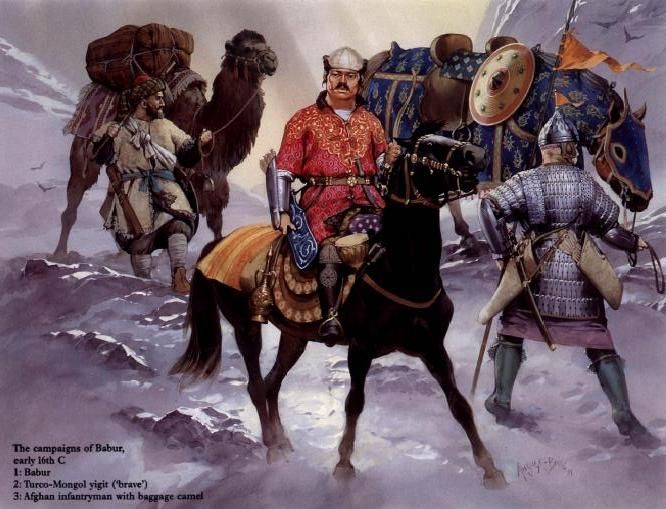Subject: yigit 'brave' cavalry trooper
Culture: Turco-Mongol
Setting: Timurid-Mughal conquest, Hindustan early 16thc
Context (Event Photos, Primary Sources, Secondary Sources, Field Notes)
* Nicolle/McBride 1993 p6
"Babur's first armies were small and consisted of Turkish, Mongol, Iranian and Afghan troops. Most of the Turks were known as yigit, 'braves' in Turkish, their officers being called begs. The Turkish military élite were cultivated men: when too old to serve as soldiers many of them took up painting, poetry or the making of high-quality bows."
* Gommans 2002 p82
"In the Mughal case the war-band dual structure is clearly recongnisable in Babur's distinction between his house corps of so-called yikitlar and his tribal allies of ichkilar and beglar. To create some kind of hierarchy within the tribal corps, an early difference was made between the tribal beglar and the somewhat inferior, intermediate position of the ichkilar. In practice, it was somewhat more complicated, as there were Baburi and Andijan Begs as well as so-called mehman Begs, or 'Guest Begs': those Begs who had already enjoyed the status of Beg under various Timurid and Mongol rulers before joining Babur. Later, the personal unit of yikitlar lived on in Akbar's standing army of a few thousand ahadis who were equipped with several horses and had a reputation for being excellent archers."
Armor
* Pant/Sharma 2001 p6
"Laminated plates or strips of metal were riveted upon leather or fabric. These palates [SIC] were called splints or strips of 'lamellae' hence the name lamellar. This kind of lamellar armour was introduced in India in the 16th century by the Mughals, which was not mounted upon leather or fabric but was made of different strips interlinked together. The miniature paintings of the Mughal School very often depict soldiers wearing lamellar armour. Similarly, some of the horses, and even elephants, were protected with this kind of armour."
* Nicolle/McBride 1993 p6 (reconstructing a Turco-Mongol yigit, early 16th century)
"Beneath his iron helmet this warrior has a quilted duwalgha burki arming cap. His qalmaq jiba heavy lamellar cuirass was sometimes described as a 'Chinese' form of armour; its iron lamellae were of different sizes for various parts of the body. His forearms are protected by normal dastana vambraces while his legs are partially covered with lamellar and mail and a small bronze dome to cover the knee. A cotton-bound spiral-cane shield hangs from his saddle." [references omitted]
Shield
* Pant/Sharma 2001 p15
"The Ain-i-Akbari mentions four kinds of shields: sipar, dhal, khera and pahri, and gives their prices as five muhars, four muhars and one muhar respectively. In the Prince of Wales Museum, Mumbai is displayed the personal shield of Akbar which carries the name of the Emperor with 12 zodiac signs (each zodiac is inscribed in a small oval shaped panel)."
* Paul 1995 p99
"The four bosses or round metal pieces in front of the shield supported four steel rings on the inner side. To these rings were attached two cross straps or loops by which the shields was held [SIC] in the left hand. In some cases, shields were equipped with an arm strap in addition to the double hand loops, secured through two extra bosses which were spaced a little further apart than the usual four. The inner lining of the shield could be cotton, velvet or brocade."
